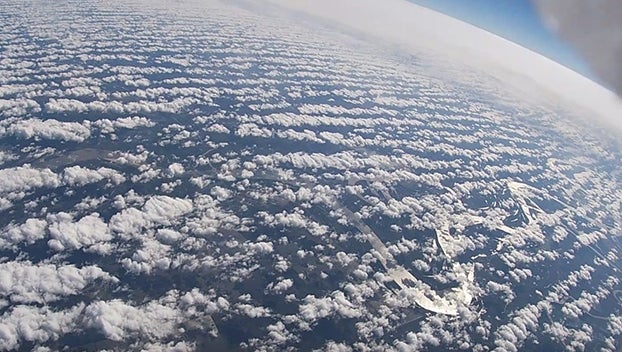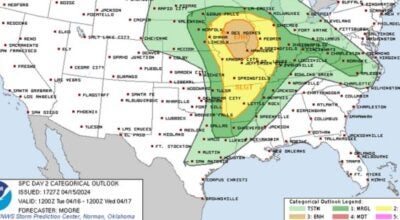Middle school’s weather balloon captures stunning footage of Earth
Published 8:10 am Sunday, December 27, 2020
Up, up and away! On Dec. 4, Father Taylor Reynolds and his eighth grade physical science students at St. Frances Cabrini School cheered as they watched a weather balloon they launched quickly float away in the clouds.
The balloon carried a payload consisting of a styrofoam container with three GoPro cameras facing different directions through holes cut in the container.
“The GoPros were obviously meant to film as much of the experience as they could,” said Reynolds.
It also contained a GPS tracker that would send a “ping” to a specific cell phone number every 10 minutes. The GPS tracker also allowed them to track the balloon’s path using Google Maps. Once the payload came down, they could also use it to find the payload’s location and retrieve it.
“We got really nice footage of the launch,” said Reynolds. The footage shows the students gathered and counting down. St. Frances Cabrini Church, along with the Walmart and Target, are visible for about 30 seconds. And then the balloon quickly floats away.
On Google Maps, the students watched where the “pings” were as the balloon headed east. Within 10 minutes of the launch, it reached Ferriday. After that, there were no more “pings” for awhile.
“That’s because it went too high up,” explained Reynolds. “It went out of range.”
Then finally, they got two “pings.” The first one told them it was in west Mississippi. The last “ping” told them the payload dropped in Homochitto National Forest. Reynolds, six students and a few other people would retrieve the cameras the following day.
The day of the launch was a cloudy one, said Reynolds, so the weather balloon reached the clouds quickly. Then, seconds later, it was above the clouds.
“As it keeps going up, you start seeing the sky change from a light blue to a very dark, dark blue,” said Reynolds. “Because it’s obviously getting higher than the atmosphere. You start seeing the clouds getting smaller.”
The students were amazed as they watched footage captured by the GoPro cameras of their weather balloon’s journey.
“They were very amazed,” he said. “The first reaction everyone has when seeing it is they can’t take their eyes off of it.”
The students were also impressed with seeing how fast the weather balloon took off.
“And they really enjoyed seeing just how high up it went and how much of space they were able to see,” he said. “They were very taken aback. Seeing how high it actually did go was kind of mind boggling for them.”
Reynolds said the cameras captured a really good picture where sunlight hit at a certain angle and the Mississippi River can be seen beneath the clouds.
“And you start seeing the sun change positions,” he said. “The last ten minutes of footage, we were able to see the Earth kind of curving.”
The balloon also got caught in a jet stream.
“Essentially, you could tell because the payload is gently swinging and you could hear a little bit the wind,” he said. “And then, the wind gets so rough and violent that you could tell that the payload is almost swinging completely horizontal.”
Footage shows the weather balloon from straight up because the payload carrying the cameras is completely flipped upside down. Everything in the payload was attached well enough so nothing fell out as the jet stream carried it.
“One of the GoPros did catch the weather balloon bursting, but none of them actually caught the descent because it took about an hour – I think an hour and 10 minutes – for it to actually go up and burst and then it probably took about equal time for it to fall back down,” he said.
Reynolds likes to do different experiments with his classes to share his love of astronomy and science.
Experiences like this expand students’ knowledge of not just the size of the universe but of our own home planet, he said, and “just how big and how amazing it can be just looking at that.”
This year, he wanted to spice things up a bit so he did some research into weather balloons. He found out other schools as well as individuals launched weather balloons for different purposes and got great footage from them going into space.
He originally thought weather balloons float for days before coming down. But the balloons go so high and the air on the outside of the balloons is so thin. That makes the pressure inside the balloon expand, sometimes up to 20 feet wide. That pressure is why the balloon bursts within a couple of hours.
There are also no restrictions on releasing weather balloons, Reynolds found out, other than the balloon and everything going up with it can’t weigh over four pounds.
Also, depending on the time of the year, climate and temperature, the balloon can go as high as 30,000 to 90,000 feet, said Reynolds, which is higher than planes fly.
The setup leading up to the launch took about a week in which he and his students discussed the Earth, the atmosphere, it’s different layers and how high up it was. They also talked about gravity, terminal velocity and air resistance.
“And we talked about the payload itself,” he said. “We started building the payload together in class.”
The students did a test drop from the bell tower at St. Frances Cabrini church to make sure the parachute would open.
“We used an eight-foot size balloon that probably burst at about 12-feet in diameter,” said Reynolds. “And then where it lands ultimately depends on how high up it goes and how long it will drift.”
He explained that if the payload is heavy and the parachute is small, it’s going to descend very fast and if the payload is small and the parachute big, it will drift for awhile.
“We chose a three-foot parachute because we thought that would give the best ratio of descent rate according to how much our payload weighed because I think it was only two pounds,” he said.
How high the balloon goes and when the balloon bursts depends on the payload’s weight, the helium in the balloon and the size of the balloon.
“The most challenging question was how much do we need to fill the thing with helium to get it to the desired height and everything we want,” he said.
Once the Cabrini School’s weather balloon burst, the payload descended at about 30 feet per second with the parachute.
“Which sounds fast but it was comparatively slow if the payload was only falling by itself,” Reynolds explained.
Where would the payload land?
“Some of the kids said they thought it was going to land in Alabama,” said Reynolds. “Most thought it would land somewhere in Mississippi. We were kind of trying to debate back and forth.”
The next day, Reynolds and his group drove to Homochitto National Forest in Mississippi to retrieve the payload. It was an optional trip for which students could receive bonus points.
“It was pretty much in the middle of the forest,” he said. They had to hike and bushwhack their way through the woods since there were no roads aside from a forest road. Fortunately, it landed close to a creek that they were able to see on Google Maps.
“Everything was there,” he said, once he spotted the orange parachute on the ground with the styrofoam container. “A little remnant of the balloon was still attached to the string. You could clearly see that it burst and the part that was attached to the parachute stayed on.”
He had hoped that someone would have found it and contacted them using the contact info provided on the container. That would have saved them the trouble of hiking in the forest to look for the payload but he thinks it would have been very cool for the students to get a random call from somebody in Mississippi telling them that they found the payload.
The experiment was more successful than he expected because the weather balloon traveled further than he thought. Even so, he was disappointed that it didn’t go further. Prior to the launch, the class calculated that the balloon would burst near Natchez, Miss.
They did have a few hiccups such as one of the GoPro cameras shifted so half the screen was covered but overall he is very pleased with how well everything worked out.
“And we got the footage,” said Reynolds. “That was all kind of cool that everything worked together.”
More photos of the footage captured by the weather balloon can be viewed on the Facebook page of St. Frances Cabrini School.





